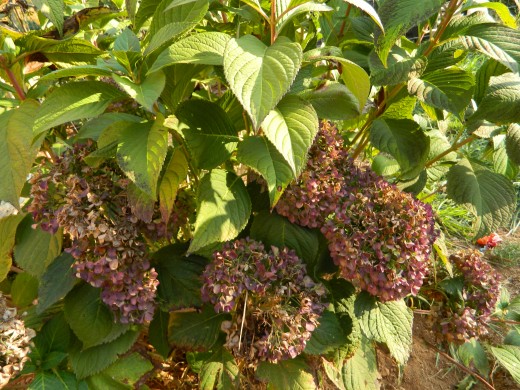How To Use Hydrangeas In Centerpieces: Preserve For Year Around Beauty
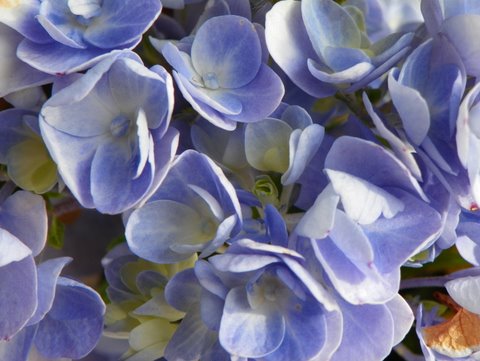
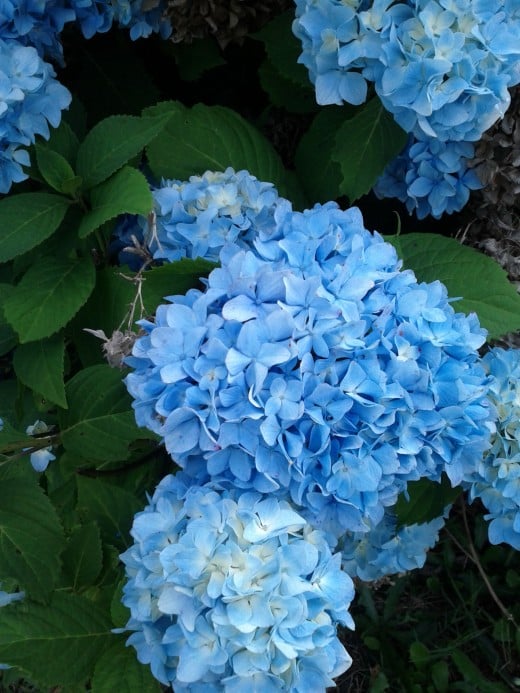
As for flowering shrubs, it's hard to beat the beauty of Hydrangeas in bloom on a Summer day. The big showy blossoms of the Moptop species are my favorite. In colors of pink, purple, blue or white, their clusters of flowers bloom profusely on single stalks.
One reason hydrangeas are such a favorite is because of their "chameleon like" ability to change color. Gardeners can pick the color of their blossoms by controlling the PH balance of the soil.
Briefly, blue hydrangeas can be changed to pink by subtracting aluminum from the soil, while adding aluminum changes pink blooms to blue ones. It is also interesting (and easier) to let them grow and change color year after year on their own as they adjust to the soil. It is not unusual to see blooms of different colors on the same bush.
The long blooming life of the hydrangea provides our gardens with many weeks of beauty. They are great for using in cut flower arrangements all through summer.
I like using them when they are a tender, pale blue with white petals that have not turned in early Spring. There are always plenty of the mop heads to grow and bloom later on. In fact, picking the blossoms seem to act as a quick pruning, causing more growth.
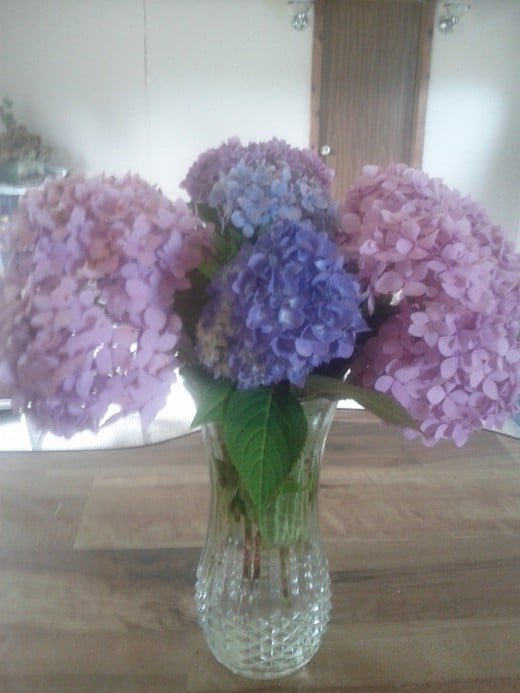
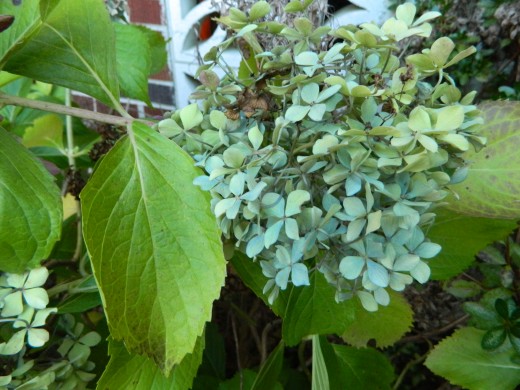
Hydrangeas Changing Color
As the summer season fades, I enjoy watching the hydrangeas change color. In warm,humid climates the blooms turn a spring-like shade of green after the blue or pink fades. Gradually, the green turns to purple. In cooler climates the blooms change to a dark purple. As the growing season declines, hydrangeas every where will eventually turn to beige, light brown and dark brown.
Hydrangeas that have morphed into green and purple look really nice in a bouquet with purple wild flowers. If you live in the deep south where killing frosts are late, try a Christmas centerpiece using the soft green colored ones. Add one or two leftover red Gerber daises or zinnias from the garden and a sprig of holly for a lovely arrangement.
The variety in colors and textures throughout the growing season make it fun and easy to create sustainable flower arrangements with hydrangeas. Learn how to get the most out of using hydrangeas in flower arrangements.
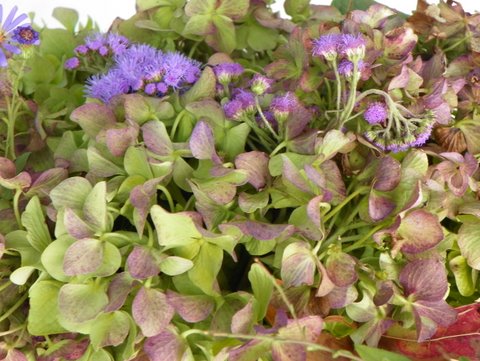
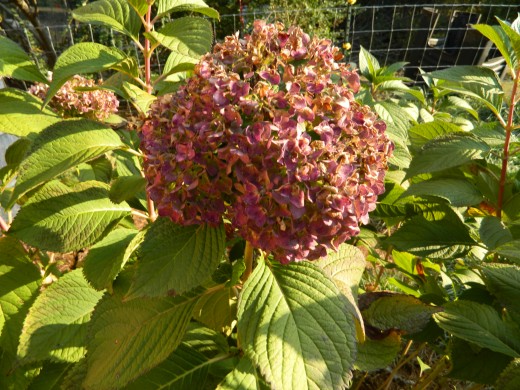
Dead Heading Hydrangeas
As you dead head, or pull fading blooms from your hydrangeas, enjoy the cut flowers indoors or outdoors on the porch or patio. Place the purple-ing blooms in glass containers, vases and baskets all around your porch and patio. Be creative in selecting containers. Do you have a nice glass tea pitcher? An old watering can? The "dead heads" will look great in it.
Moptop Hydrangeas do not need pruning. However, some people like to prune them when they are older, and that's OK. Just be sure not to prune them during the Spring and Summer months while they are still growing. Another tip: After the first of August, cut short stems so as not to disturb the bloom buds.
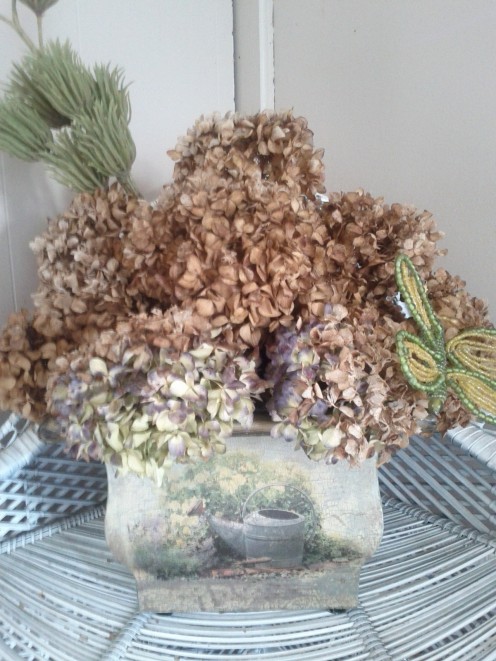
Preserving Hydrangea blossoms with silica gel is a multistep process that I have yet to try. According to those who have, the effort is well worth it, as they reportedly look freshly cut. Borax and cornmeal is said to be a good medium for flower drying. Apparently, this will have good results and costs less. That really makes me want to try it! But for this year I will be content with drying mine.
Drying Hydrangeas is incredibly easy because all you do is pick them. In fact, the recommended method for drying them is to leave them on the bush. Pick them when they are almost totally brown. Then pick the prettiest blooms, the ones with a good shape and have not yet crumbled. Spray with clear Latex gloss and then think of ways to add creativity and color. They will look much better if you dress them up in an arrangement.
Lovely Hydrangea Arrangements
Hydrangeas can be used in a variety of arrangements all year long. See suggestions for lovely early blooming, late blooming and dried arrangements for year-long beauty at mycreativepalette.
Silk Hygranges Have a Real Look
Protecting Hydrangeas in Winter
Hydrangeas are surprisingly hardy.Unless you live in a growing zone that experiences single digit temperatures more than a few days in winter, you really need to do nothing. If you do live in a frigid zone in winter you can winterize them by putting a cage-like enclosure around them. Fill the enclosure with insulating materials such as leaves and pine straw. If you do this carefully then next Spring the cycle of enjoying your Hydrangeas the year around can begin again!
